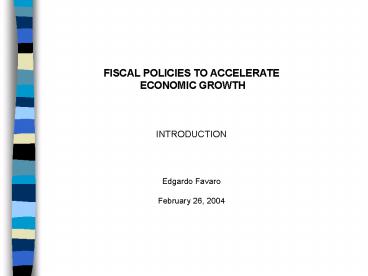FISCAL POLICIES TO ACCELERATE - PowerPoint PPT Presentation
1 / 13
Title:
FISCAL POLICIES TO ACCELERATE
Description:
... Government consistently borrowed at a cheaper rate than the US Government for ... (MTYIELD) and an 18 years moving average of US Government 10 year Treasury bills. ... – PowerPoint PPT presentation
Number of Views:13
Avg rating:3.0/5.0
Title: FISCAL POLICIES TO ACCELERATE
1
FISCAL POLICIES TO ACCELERATE ECONOMIC
GROWTH INTRODUCTION Edgardo Favaro
February 26, 2004
2
IN INDIA HIGH RATES OF ECONOMIC GROWTH HAVE
CONCURRED WITH HIGH FISCAL DEFICITS FOR TWO
DECADES The average rate of growth
of real GDP from 1982 to 2002 was 5.8 percent. In
turn, the average ratio of the fiscal deficit of
the General Government to GDP was 8.3 percent.
3
MEASURED IN THIS WAY ARGENTINA OR BRAZILS
HISTORY OF FISCAL INDISCIPLINE PALES IN
COMPARISON. HOWEVER, WITH THE EXCEPTION OF
1991, HIGH FISCAL DEFICITS HAVE NOT SPILLED OVER
THE EXCHANGE RATE AND THE BALANCE OF PAYMENTS (AN
EXPERIENCE VERY DIFFERENT FROM THAT OF ARGENTINA
AND BRAZIL).
4
THESE STATISTICS RAISE A NUMBER OF QUESTIONS
Are high fiscal deficits
sustainable, say in the next five years?
What are the roles of tax revenue
enhancing measures and government spending cuts
in a deficit reduction strategy?
5
Are high fiscal deficits sustainable in the
medium term?
Note SDEBT2 is the ratio between the public
sector debt and the GDP.
6
FACTORS EXPLAING SUSTAINABILITY
And, deficit adjusted by inflation measure
(ADJDEF) is
7
The relevant measure of the fiscal deficit is not
DEF (the ratio between the GG deficit and the
GDP), but rather the ratio between the deficit
adjusted by inflation and the GDP (i.e. the
dotted line).
8
Notice that the true fiscal problem appears
after 1998 as a result of the fall in inflation!
9
FINANCIAL REPRESSION HAS KEPT DOMESTIC INTEREST
RATES BELOW THE OPPORTUNITY COST OF CREDIT IN THE
INTERNATIONAL MARKET
For instance.with the exception of the early
1990s, the India Government consistently borrowed
at a cheaper rate than the US Government for the
past thirty years. 1 , 2
___________________________
1 The illustration is based on a comparison
between an 18 years moving average of the yield
on Indian 10 year Treasury bills arbitraged to
dollar (MTYIELD) and an 18 years moving average
of US Government 10 year Treasury bills.
2 In addition, steady inflation and high
monetization have also had a positive fiscal
effect through the creation of revenue from
seignorage.
10
- SEVERAL CONCLUSIONS
- In the past, Indias ability to sustain high
fiscal deficits depended on the capacity of the
public sector to borrow at lower than
international rates and on monetary policy
maintaining inflation continuously above
international levels. - Maintaining this financial repression financing
scheme implies limits to the capacity of the
Government of India to open up financially to the
rest of the world. If it does it, as it has
been announcing for several years, it will have
to bear the cost of higher interest rates. - The fall in inflation after 1998 implied the loss
of an important source of revenue. - This source of revenue has not been yet replaced
by an increase in more conventional sources of
tax revenue.
11
SEVERAL CONCLUSIONS (CONTD)
- At this moment the fiscal and monetary policy
combination is not sustainable. However, a
balance of payment crisis is very unlikely. - Persistence of fiscal deficits at the current
rate (average of the past three years) will most
likely result in an increase in money-income
velocity and average inflation. - Alternatively, accepting a permanent fall in
revenue from inflation (and an increase in
government borrowing costs) will have to be
offset by a permanent increase in revenue from
alternative sources. - Reducing government spending as a proportion of
GDP in India is probably not an alternative for a
public sector that is highly indebted and needs
to spend heavily in improving the level of human
capital and basic infrastructure.
12
WHAT ARE THE ROLES OF TAX REVENUE ENHANCING
MEASURES AND GOVERNMENT SPENDING CUTS IN A
DEFICIT REDUCTION STRATEGY? A FEW
NUMBERS 29 of central government spending
finances interest payments 16 defense 16
administrative spending 8 subsidies and 26
planned expenditure.
13
WHAT IS NEEDED IN INDIA IS PERHAPS a
medium-term strategy, spread over a 3-5 year
horizon, focusing on not only reversing the
downward trend in the revenue-to-GDP ratio
observed during the 1990s but increasing the
ratio, and a deep restructuring of
expenditure with a pronounced shift in emphasis
from current to capital expenditure.































